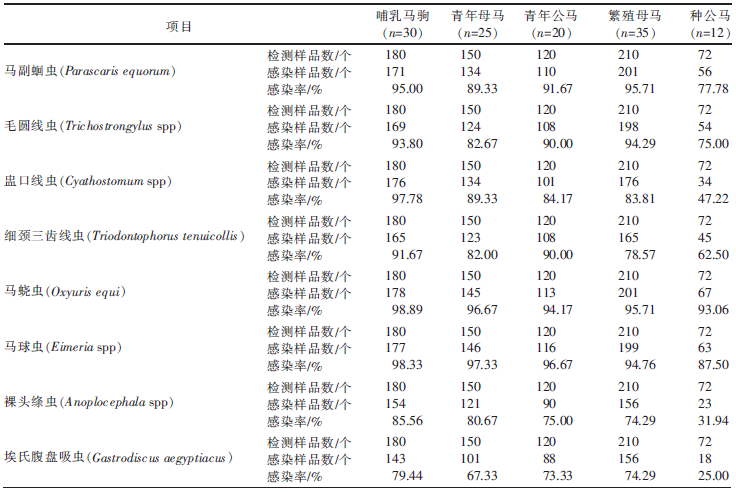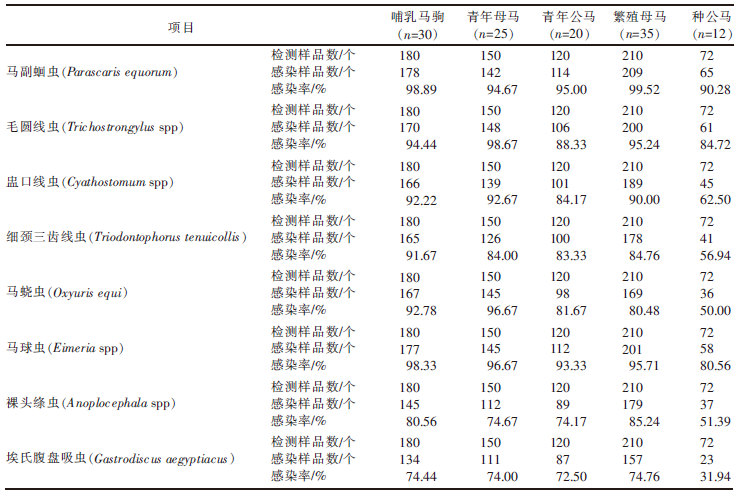畜牧与饲料科学 ›› 2022, Vol. 43 ›› Issue (4): 122-128.doi: 10.12160/j.issn.1672-5190.2022.04.018
• 动物疾病防控 • 上一篇
新疆昭苏地区纯血马寄生虫感染情况研究
李倩1,徐文慧2,马玉辉1,3,吕燕3,李海1,3
- 1.新疆农业大学动物科学学院,新疆 乌鲁木齐 830052
2.伊犁哈萨克自治州国家农业科技园区马产业发展服务中心,新疆 昭苏 835600
3.昭苏县畜牧兽医发展中心,新疆 昭苏 835600
Parasitic Infection Status of Thoroughbred Horses in Zhaosu County of Xinjiang
LI Qian1,XU Wen-hui2,MA Yu-hui1,3,LYU Yan3,LI Hai1,3
- 1. College of Animal Science,Xinjiang Agricultural University,Urumqi 830052,China
2. Horse Industry Development Service Center,National Agricultural Science and Technology Park of Ili Kazak Autonomous Prefecture,Zhaosu 835600,China
3. Zhaosu County Animal Husbandry and Veterinary Medicine Development Center,Zhaosu 835600,China
摘要:
[目的]研究分析新疆昭苏地区不同性别、不同年龄段纯血马在不同月份的寄生虫感染情况,为纯血马的健康养殖以及科学驱虫提供参考。[方法]随机选取不同年龄段纯血马122匹,分为5组,哺乳马驹30匹,青年母马25匹,青年公马20匹,繁殖母马35匹,种公马12匹。采用马场分栏群体舍饲和单厩饲养模式,保证不同年龄段纯血马饲料和饮水充足,分别在5月和10月采集粪便样品。使用虫卵计数法检测马匹粪便中的寄生虫,计算不同年龄纯血马在不同时间段的寄生虫感染率和感染强度。[结果]5月纯血马马蛲虫以及马球虫感染率较高,除种公马外,感染率均在94.00%以上,其中,哺乳马驹马蛲虫的感染率高达98.89%,哺乳马驹马球虫的感染率高达98.33%。10月纯血马马副蛔虫以及马球虫的感染率均在93.00%以上,其中,繁殖母马马副蛔虫感染率高达99.52%,哺乳马驹马球虫感染率高达98.33%。5月哺乳马驹的马副蛔虫、毛圆线虫、盅口线虫与细颈三齿线虫感染强度均显著(P<0.05)高于其他年龄段的纯血马;马蛲虫、马球虫和埃氏腹盘吸虫的感染强度显著(P<0.05)高于种公马,与其他阶段纯血马相比差异不显著(P>0.05)。10月哺乳马驹马副蛔虫、毛圆线虫、裸头绦虫感染强度显著(P<0.05)高于除繁殖母马以外的其他年龄段纯血马,细颈三齿线虫感染强度显著(P<0.05)高于其他年龄段纯血马,马球虫和埃氏腹盘吸虫的感染强度显著(P<0.05)高于种公马。种公马马副蛔虫与细颈三齿线虫感染强度显著(P<0.05)低于其他阶段的纯血马。不同年龄段纯血马马蛲虫感染强度差异不显著(P>0.05)。[结论]纯血马感染的肠道寄生虫主要有马蛲虫、马球虫、毛圆线虫、细颈三齿线虫、盅口线虫、马副蛔虫、裸头绦虫以及埃氏腹盘吸虫,不同年龄段、不同月份均有感染,且混合感染较为严重。哺乳马驹感染强度及感染率普遍高于其他年龄段纯血马。
中图分类号:




